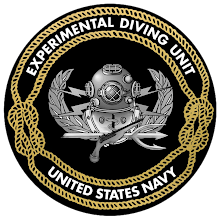We are sorry to report that Maino des Granges has passed. He was a retired Navy Captain and in the 1950s he was the OIC of NEDU in the Washington Navy Yard. During his time at NEDU the dive tables that we used for over 50 years were developed. We've attached his obituary.
22Sep09 - As a youth growing up in
As a Navy officer and entrepreneur, he used his skills to come up with inventions to assist in diving and construction. As a retiree wanting to improve his golf game, he designed and built a collapsible driving-range cage and putting green in his yard, complete with sand trap.
Capt. des Granges died Aug. 19 after suffering a heart attack while attending a Padres game. He was 91.
Friends and relatives said Capt. des Granges was a quiet, unassuming, self-made man who enjoyed coming up with solutions to problems.
After enlisting in the Navy in 1936, he was selected for appointment to the
He graduated from the academy in December 1941 and was assigned to submarine patrol in January 1942. After completing three war patrols, he was able to attend submarine school. "He was pretty sharp," said friend and fellow Navy veteran Charles Bishop. "He was made commanding officer (in 1943) and was one of the youngest at the time."
In the 1950s, Capt. des Granges was officer in charge of the Navy Experimental Diving Unit in
Capt. des Granges was a "fearless, remarkable man's man," son-in-law Ned Chambers said. "I think I hit the father-in-law lotto. ... He was the most honorable, phenomenal human being."
Although he was given six months to live after undergoing melanoma surgery several decades ago, Capt. des Granges "just went on with his life and beat it," Chambers said.
He enjoyed tinkering around his home and yard into his late 80s. Chambers remembered getting a call from his mother-in-law several years ago when Capt. des Granges had fallen and dislocated his hip while building a concrete wall in his yard. "The paramedics were there and he was telling them, `Just pull it back in so I can get back to work.' "
"He was his own man," Chambers said, noting that Capt. des Granges' 1963
After retiring from the Navy in 1966, Capt. des Granges became the owner and operator of Superior CATV Construction, a major installer of underground cable. The business had nearly 200 employees at one time and had offices in
"He was energetic and innovative, and everybody who worked with him just loved him," said Wade Harris, who served under Capt. des Granges when he was division commander and Harris was an executive officer. "He was one of the finest naval officers I ever met. He had a quiet, unassuming personality, but he was outstanding at his job."
Maino des Granges was born Aug. 2, 1918, in
He married the former Dorothy Beckley in 1942. They settled in
He is survived by his wife, Dorothy, of Point Loma; daughters, Jeanne Vivoli and Anne Chambers of



 USS SAILFISH
USS SAILFISH H/Y
H/Y





